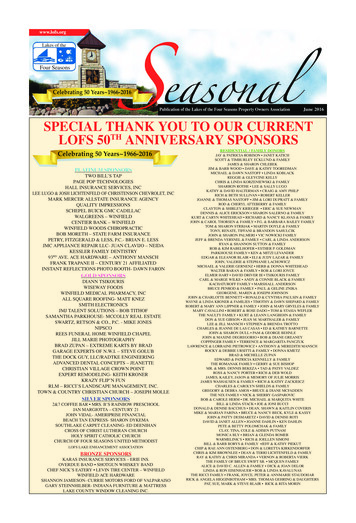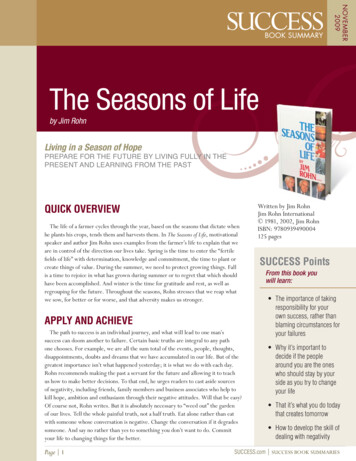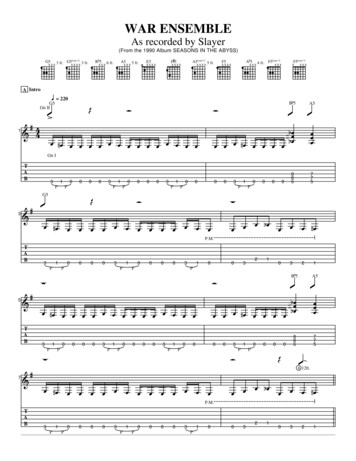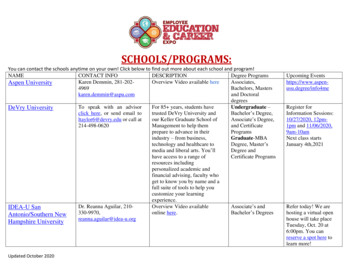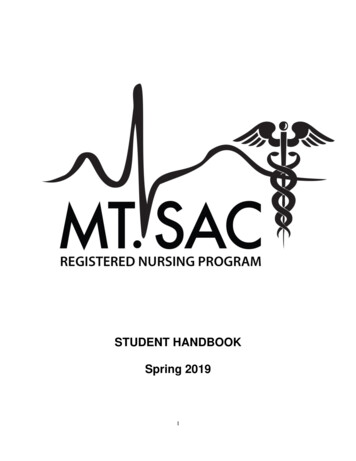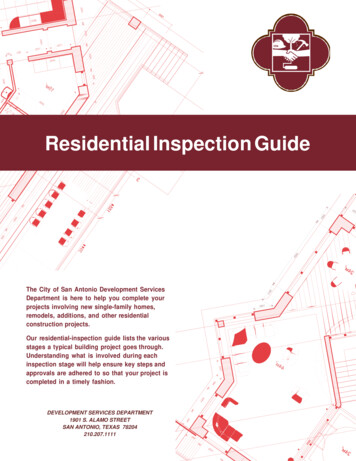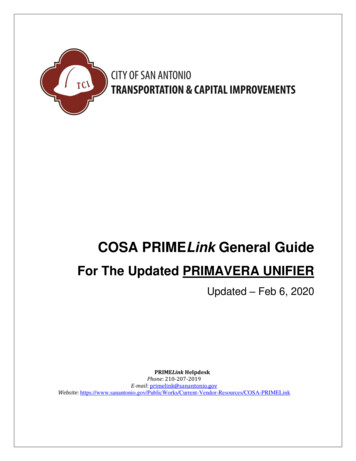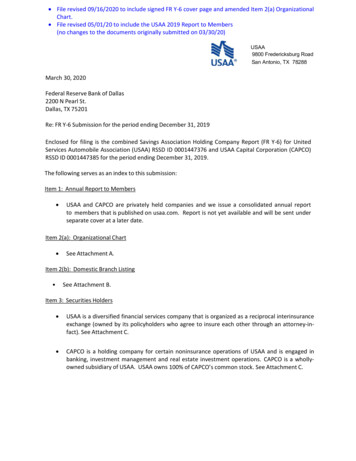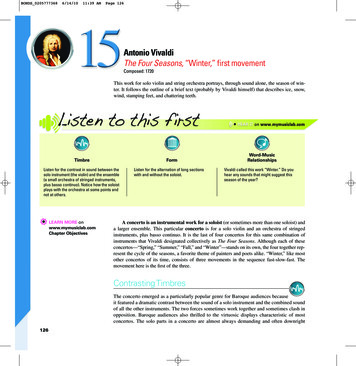
Transcription
BONDS 02057773686/14/1011:39 AMPage 126Antonio VivaldiThe Four Seasons, “Winter,” first movementComposed: 1720This work for solo violin and string orchestra portrays, through sound alone, the season of winter. It follows the outline of a brief text (probably by Vivaldi himself) that describes ice, snow,wind, stamping feet, and chattering teeth.TimbreFormListen for the contrast in sound between thesolo instrument (the violin) and the ensemble(a small orchestra of stringed instruments,plus basso continuo). Notice how the soloistplays with the orchestra at some points andnot at others.LEARN MORE onwww.mymusiclab.comChapter ObjectivesListen for the alternation of long sectionswith and without the soloist.Word-MusicRelationshipsVivaldi called this work “Winter.” Do youhear any sounds that might suggest thisseason of the year?A concerto is an instrumental work for a soloist (or sometimes more than one soloist) anda larger ensemble. This particular concerto is for a solo violin and an orchestra of stringedinstruments, plus basso continuo. It is the last of four concertos for this same combination ofinstruments that Vivaldi designated collectively as The Four Seasons. Although each of theseconcertos—“Spring,” “Summer,” “Fall,” and “Winter”—stands on its own, the four together represent the cycle of the seasons, a favorite theme of painters and poets alike. “Winter,” like mostother concertos of its time, consists of three movements in the sequence fast-slow-fast. Themovement here is the first of the three.Contrasting TimbresThe concerto emerged as a particularly popular genre for Baroque audiences becauseit featured a dramatic contrast between the sound of a solo instrument and the combined soundof all the other instruments. The two forces sometimes work together and sometimes clash inopposition. Baroque audiences also thrilled to the virtuosic displays characteristic of mostconcertos. The solo parts in a concerto are almost always demanding and often downright126
BONDS 02057773686/14/1011:39 AMPage 127CHAPTER 15flamboyant. Both as a composer and as a player, Vivaldi took the art of virtuoso violin playingto new levels. He worked in a time and a place—early eighteenth-century northern Italy—inwhich violin making and violin playing were at their very peak: to this day, the best violinssuch as those made by Antonio Stratavari or “Stradivarius” (the Latinized form of his name)are from that time. How the great violin makers produced their instruments is not entirelyknown to us today, but the features of the violin basically remain the same (see A CloserLook: The Violin, page 000).The appeal of the concerto’s contrasting timbres and its inherent virtuosity lasted beyond theBaroque period and into the present day. The concerto has undergone changes over the centuriesbut remains a popular genre among composers and audiences alike. Many modern symphonyorchestra concert programs feature a concerto—from the Baroque or from a later period—andVivaldi’s masterful opposition of solo and large-group string timbres has given The FourSeasons lasting fame.Form: The Ritornello PrincipleThis movement consists of a series of alternating sections between the orchestra (alsoknown as the tutti, Italian for “all”) and the soloist. Each statement and return of the full ensemble is known as the ritornello (Italian for “little [i.e., brief] return”). This formal design of alternating ritornello and solo sections is known as the ritornello principle and is basic to almost allconcerto movements of the Baroque Era. The form of this movement, based on the ritornelloprinciple, can be represented graphically in this way:Ritornello 1Solo 1Ritornello 2Solo 2Ritornello 3Solo 3Ritornello 4The form of the movement is also structured around large-scale changes of key area. Akey area is a set of harmonies that all have a distinctive relationship to one particular note,known as the tonic. At the beginning and end of this movement, that tonic note is F, andbecause the mode is minor, this central key area is called “F minor.” F minor acts as the“home” key, and it is by definition the key in which the movement begins and ends. (If itclosed in a different key, the ending would not sound as conclusive.) But if the entire movement were in a single key, it would sound monotonous, and so Vivaldi moves the music to keyareas other than the tonic—including some in the major mode. These other key areas providea sense of harmonic variety.The ritornello principle is found not only in concertos, but in almost every Baroque workthat contrasts a soloist or group of soloists against a larger ensemble. Operatic arias, forexample, routinely open with an instrumental ritornello (Ritornello 1), followed by theentrance of the voice (Solo 1), a brief return of the orchestra without the voice (Ritornello 2),a reentry of the voice (Solo 2), and so on. Composers and audiences of the Baroque relishedthe sound of contrasting forces, and the ritornello principle provided the perfect means bywhich to present such contrasts.Antonio Vivaldi1271678–1741Antonio VivaldiFour Seasons, “Winter,”first movementComposed: 1720GENREConcertoKEY CONCEPTSConcerto, ritornello, violin,program music.CHAPTER HIGHLIGHTProgram MusicProgram music is instrumentalmusic explicitly connected in someway with a story, person, or idea.This first movement of a threemovement concerto for violin andstring orchestra captures some ofthe season’s sounds. It follows theoutline of a brief text (probably byVivaldi himself) that describes ice,snow, wind, stamping feet, andchattering teeth.
BONDS 02057773681286/14/10PART 311:40 AMPage 128The Baroque EraSectionRitornello 1Solo 1Ritornello 2Solo 2Ritornello 3Key AreaF minorC minorF minorF minorEb MajorSolo 3E b MajorC minorRitornello 4F minorVariety: Modulates to different (non-tonic) keysUnity: Begins and ends in F minor (the tonic key)and re-establishes F minor in the middleWord-Music Relationships: Program MusicThe form of this particular concerto is also shaped by its relationship to a poem(“Winter”) that Vivaldi appended to the first publication of the score in 1725. He indicatedquite precisely which lines of the following poem corresponded to specific points of the concerto. This concerto is thus an example of program music, an instrumental work that is insome way associated with a story, event, or idea. A composer can indicate such connections bya suggestive title, a prose or poetic narrative, or both. A listener may choose to listen to thepiece with the program in mind—in the case of Vivaldi’s “Winter,” hearing the strings shakingas if with cold in Ritornello 1, a stamping of feet in Ritornello 2, and a chattering sound in theSolo 3—or simply listen to the piece as music that does not represent anything besides itself.Indeed, some composers (for example, Berlioz—see chapter 30), have gone back and forthabout whether their audiences should be aware of a program or simply be allowed to hear themusic as it unfolds.First movement:The ConcertoFind an example of a piece thatfeatures a contrast between a soloinstrument and a larger ensemble.Example: Stevie Ray Vaughan,“Say What” (1985)This song, featuring almost no words,is essentially a concerto for solo electric guitar (it also features an organsolo, though less prominently).Second movement:Third movement:“Winter”To tremble from cold in the icy snowIn the harsh breath of a horrid windTo run, stamping our feet every momentOur teeth chattering in the extreme cold.Before the fire to pass peaceful, contented days,While the rain outside pours down.To walk on the ice and, at a slow paceFor fear of falling, move carefully.To make a bold turn, slip, fall down.To go on the ice once more and run hardUntil the ice cracks and breaks up.To hear the Sirocco [the north wind], Boreas [the south wind], and allThe winds at war leave their iron gates:This is winter, but even so, what joy it brings!Antonio Vivaldi, The Four Seasons, op. 8, nos. 1–4, ed. Eleanor Selfridge-Field (New York: Dover, 1999) xiii.
BONDS 02057773686/14/1011:40 AMPage 129CHAPTER 15PROFILEAntonio VivaldiAntonio Vivaldi (1678–1741)Composing for Orphansnown as the “Red Priest” because he was red-haired andordained, Antonio Vivaldi served for many years as director of music at Venice’s Ospedale della Pietà (“Hospice ofCompassion”), a large orphanage for girls. Being the musicdirector of an orphanage might strike us today as a strangejob for one of the most famous composers of his time, butjudging from the music Vivaldi wrote for the young women atthis particular institution, they must have been quite talentedindeed. He actually wrote most of his concertos while in service to the orphanage.Vivaldi was extremely prolific. He wrote almost 350 soloconcertos (about two-thirds of which are for solo violin) and 45double concertos (more than half of which are for two violins).His music was widely published and admired throughoutEurope during his lifetime. J.S. Bach arrangedseveral of Vivaldi’s concertos for theorgan and in the process taught himself how to write concertos “in theMilanItalian style.” Bach and Handel mayhave had greater facility at counVENICEterpoint, but Vivaldi was a masterRomeofmelodic invention and formalITALYnovelty. Almost every one ofVivaldi’s concertos contains somePalermounusual twist that makes it differentfrom all the rest.KAntonio Vivaldi was famous both as a composer andas a violinist during his lifetime. His red hair is covered by his wig.Lebrecht Music & Arts Photo LibraryEXPLORE MORE on www.mymusiclab.comEXPAND YOUR PLAYLIST: VIVALDI The Four Seasons: “Spring.” The opening theme (Ritornello 1)is now a popular ringtone for cell phones. Gloria, RV 589, for chorus and orchestra. A thrilling setting of theGloria portion of the Mass Ordinary. The Four Seasons: “Summer.” The finale depicts a violentthunderstorm. Concerto for Flute, Strings, and Basso Continuo, op. 10, no. 1.Nicknamed “The Tempest at Sea” because of its stormy sound. The Four Seasons: “Fall.” The finale depicts a hunting scene. Concerto for Mandolin, RV 532. More typically associated withbluegrass music, the mandolin was already a popular instrument in the Baroque.Now listen to the movement, using the Listening Guide.HEAR SAMPLES on www.mymusiclab.com129
BONDS 02057773686/14/1011:40 AMPage 130GO TO www.mymusiclab.comfor the Automated Listening GuideCD II Track 2/Download Track 37Antonio Vivaldi Composed: 1720 The Four Seasons, “Winter,” first movement (3:33)TimeHarmony:Key AreaMelodyFormWord-Music Relationships(1): The Poetry0:001F minorRitornello 1To tremble from cold in the icy snow0:372C minorSolo 1In the harsh breath of a horrid wind0:59 1:121 3F minorRitornello 2To run, stamping our feet every moment1:264F minor unstableSolo 22:051Eb majorRitornello 32:255Eb major C minorSolo 33:043F minorRitornello 4Our teeth chattering in the extreme coldI can’t hear the difference in key areas between the sections. How can I learn tohear these changes?With digital technology, it’s easy to make side-by-side comparisons. Using theListening Guide, start the music at 0:37. The long note to which the solo violinistkeeps returning is C, the tonic of C minor. Let the music runthrough 1:00. Vivaldi again and again emphasizes this newkey area of C minor. Now go back to the beginning, whichis in F minor. Hear the difference? The main note at thebeginning is F, the root of the tonic key of F minor. Now letthe music run through and listen for the change of keybetween the opening and 0:37. This may take sometime at first, but once you start listening for changesof key, it gets easier to recognize them. And even ifyou don’t always hear the key changes consciously,you will appreciate that they affect the way the musicsounds by providing both harmonic unity (the tonic)and variety (all other keys).130
BONDS 02057773686/14/1011:40 AMPage 131EXPAND YOUR PLAYLISTProgram MusicProgram music—instrumental music explicitlyconnected in some way with a story, person, oridea outside the music itself—has long fired theimaginations of composers and listeners. Johann Kuhnau, Six Biblical Sonatas (1700)Word-Music Relationships(2): The MusicRepetitive figure in the strings suggests trembling.The solo violin also “trembles” and moves from high to low, like the wind.Faster tempo (“running”); the music begins to “stamp” at 1:12.Each of these six sonatas for harpsichord depictsa famous story from the Bible. When Daviddefeats Goliath, we “hear” the stone hurledtoward the giant and the enormous thud when hefalls to the ground. Marin Marais, An Image of AbdominalSurgery (1725)A lengthy work for solo viola da gamba, it depictsin great detail the removal of a gallstone. Thescore includes such comments as “The Incision,”“Blood Flows,” and “The Stone Is Removed.” Ludwig van Beethoven, Wellington’s Victory,op. 91 (1813)The soloist bounces the bow very rapidly against the string, creating a“chattering” sound (2:35–3:03).Depicts the victory of the English general overNapoleon’s forces at the Battle of Vittoria (Spain).The opening mimics the trumpet calls of thearmies, and the percussion simulates the soundsof cannon and musket fire. Hector Berlioz, Symphonie fantastique (1830)See chapter 30. George Gershwin, An American in Paris (1928)What does the violin soloist do duringthe tutti sections?The soloist actually plays along with thefirst violin section of the orchestra. Butbecause the sound of the solo instrumentblends into the sound of the orchestra, thesoloist cannot be heard as a separate, distinct voice in these sections.Which is more important,the musical or theprogrammatic form?The two work in tandem and reinforce each other. We do not know ifVivaldi began with the poem andwrote a concerto around it, or ifhe began with a concerto andwrote a poem around it. It’s alsopossible that the two processestook shape simultaneously.This work recreates, in sound, impressions ofParis, including honking horns of the traffic,French spee
To go on the ice once more and run hard Until the ice cracks and breaks up. To hear the Sirocco [the north wind], Boreas [the south wind], and all The winds at war leave their iron gates: This is winter, but even so, what joy it brings! The Concerto Find an example of a piece that features a contrast between a solo instrument and a larger ensemble. Example: Stevie Ray Vaughan, “Say What .
